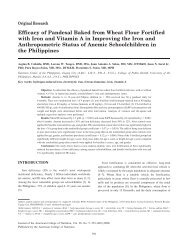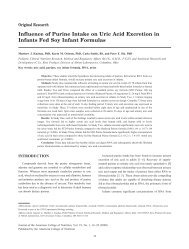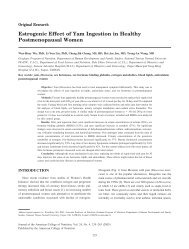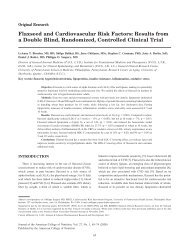Absence of Allergic Reactions to Egg White Lysozyme Additive in ...
Absence of Allergic Reactions to Egg White Lysozyme Additive in ...
Absence of Allergic Reactions to Egg White Lysozyme Additive in ...
You also want an ePaper? Increase the reach of your titles
YUMPU automatically turns print PDFs into web optimized ePapers that Google loves.
the lysozyme were added <strong>to</strong> CNBr-activated paper [19]. After<br />
<strong>in</strong>cubation <strong>of</strong> the RAST disk <strong>in</strong> 50 �l <strong>of</strong> the patient’s serum for<br />
18 h at 4°C, the RAST disk was washed three times <strong>in</strong> phosphate-buffered<br />
sal<strong>in</strong>e (PBS) conta<strong>in</strong><strong>in</strong>g 0.5% Tween 20 (PBS-<br />
Tween). The disk was placed <strong>in</strong> 50 �l <strong>of</strong> 125 I-conjugated<br />
anti-human IgE (Da<strong>in</strong>abot Co., Tokyo, Japan) for 18 h at room<br />
temperature and r<strong>in</strong>sed with PBS-Tween three times, followed<br />
by count<strong>in</strong>g <strong>in</strong> a gamma counter. Per-cent b<strong>in</strong>d<strong>in</strong>g was calculated<br />
by the follow<strong>in</strong>g formula:(bound iso<strong>to</strong>pe count / added<br />
<strong>to</strong>tal count iso<strong>to</strong>pe <strong>of</strong> 125 I-antihuman IgE)�100.<br />
Statistics<br />
Data are reported as mean � SEM, unless otherwise specified.<br />
Data analyses were performed with PROC ANOVA <strong>of</strong><br />
SAS 8.0 statistical package. Two-sided P � 0.05 was regarded<br />
as significant.<br />
The Wilcoxon signed rank test was performed <strong>to</strong> compare<br />
data from the same subjects before and after cheese oral test,<br />
the P values were adjusted us<strong>in</strong>g the Bonferroni method. The<br />
comparison between groups was performed by Mann-Whitney<br />
method for non-parametric <strong>in</strong>dependent two-group comparisons.<br />
The distribution <strong>of</strong> the residuals, test<strong>in</strong>g for normality and<br />
check<strong>in</strong>g the l<strong>in</strong>earity assumptions <strong>in</strong> the model by means <strong>of</strong><br />
standard scatter plots. The areas under the curve <strong>of</strong> the lysozyme<br />
time courses were calculated us<strong>in</strong>g a trapezoidal rule.<br />
RESULTS<br />
Lysozyma Concentration <strong>in</strong> Cheese<br />
Grana Padano cheese used for the test, was produced <strong>in</strong> July<br />
2004 after 18 months <strong>of</strong> ripen<strong>in</strong>g. <strong>Egg</strong> lysozyme (trade products<br />
Hansozyma) was used <strong>in</strong> cheese-mak<strong>in</strong>g <strong>to</strong> prevent late<br />
blow<strong>in</strong>g by h<strong>in</strong>der<strong>in</strong>g growth <strong>of</strong> Clostridium tyrobutyricum.<br />
The concentration <strong>of</strong> lysozyme found <strong>in</strong> sample <strong>of</strong> Grana<br />
Padano cheese was 155 � 5 mg/kg and the dry matter expressed<br />
<strong>in</strong> per cent by weight was 67.90.<br />
Plasma <strong>Lysozyme</strong> Levels<br />
The area under the curve (AUC) <strong>of</strong> the serum lysozyme<br />
concentrations was significantly higher <strong>in</strong> patients than <strong>in</strong> controls<br />
<strong>in</strong>dependently <strong>of</strong> the amounts <strong>of</strong> Grana Padano challenged<br />
(Table 1).<br />
No dose-response curve was detected us<strong>in</strong>g progressively<br />
higher amounts <strong>of</strong> Grana Padano.<br />
Serum <strong>Lysozyme</strong> Specific IgE<br />
None <strong>of</strong> the patients developed positive reactions either<br />
immediate - i.e. developed with<strong>in</strong> 1 hour after consum<strong>in</strong>g the<br />
cheese-, late - i.e. those symp<strong>to</strong>ms which occurred with<strong>in</strong><br />
several <strong>to</strong> 24 hours -, or delayed - i.e. those symp<strong>to</strong>ms that<br />
occurred after several days.<br />
Table 1. AUC (Area under the Curve, �g/ml � m<strong>in</strong>, Mean �<br />
SE) <strong>of</strong> <strong>Lysozyme</strong> Serum Concentration, after Consumption<br />
<strong>of</strong> Increas<strong>in</strong>g amount <strong>of</strong> Grana Padano Cheese, <strong>in</strong> <strong>Egg</strong> <strong>White</strong><br />
Sensitive and Non-Sensitive Subjects<br />
Amount <strong>of</strong> adm<strong>in</strong>istered<br />
Grana Padano<br />
cheese (g)<br />
a,b (p � 0.01)<br />
RAST values were expressed as the mean percent bound <strong>of</strong><br />
the <strong>to</strong>tal 125 I-labelled anti-IgE added. Positive RAST was def<strong>in</strong>ed<br />
as the percentage bound greater than 3%. S<strong>in</strong>ce no significant<br />
differences <strong>in</strong> serum lysozyme levels, no cl<strong>in</strong>ical reactions<br />
and no significant differences among values <strong>in</strong> the<br />
different experimental sessions were observed, the RAST values<br />
reported <strong>in</strong> the results were averaged from the data relative<br />
<strong>to</strong> the three cheese challenges.<br />
RAST values <strong>in</strong> controls were 0.84 � 0.47%.<br />
Among the 20 patients with a his<strong>to</strong>ry <strong>of</strong> egg white allergy<br />
tested, 17 (85%) had basel<strong>in</strong>e serum lysozyme specific IgE<br />
(mean � SD � 4.24 � 1.02 %), and between the latter only 3<br />
(15%) showed positive IgE antibody responses <strong>to</strong> Grana<br />
Padano cheese (subject 5 from 4.7% <strong>to</strong> 5.10%, subject 7 from<br />
5.00 <strong>to</strong> 6.10% and subject 18 from 4.33 <strong>to</strong> 5.63% (overall<br />
RAST mean 4.45 � 1.25 %, P � n.s.).<br />
DISCUSSION<br />
<strong>Lysozyme</strong> <strong>in</strong> Grana Padano Cheese<br />
Sensitive<br />
subjects<br />
5 330.2 � 9.9 b<br />
15 330.9 � 10.1 b<br />
60 335.5 � 10.3 b<br />
AUC (�g/ml � m<strong>in</strong>)<br />
Non Sensitive<br />
subjects<br />
244.5 � 14.0 a<br />
235.8 � 14.2 a<br />
254.4 � 14.5 a<br />
Hen egg white lysozyme is a 14.3 kDa prote<strong>in</strong> formed by a<br />
s<strong>in</strong>gle cha<strong>in</strong> <strong>of</strong> 129 am<strong>in</strong>o acids. Its structure consists <strong>of</strong> 5–7 �<br />
helices and a 3-stranded antiparallel � sheet [20]. Its function is<br />
<strong>to</strong> hydrolyze the �(1–4) glycosidic bond between residues <strong>of</strong><br />
N-acetylmuramic acid and N-acetylglucosam<strong>in</strong>e <strong>in</strong> certa<strong>in</strong><br />
polysaccharides conta<strong>in</strong>ed <strong>in</strong> many bacterial cell walls.<br />
For these antibacterial properties, lysozyme from hen egg<br />
white was used <strong>in</strong> cheese-mak<strong>in</strong>g <strong>to</strong> prevent late blow<strong>in</strong>g by<br />
h<strong>in</strong>der<strong>in</strong>g growth <strong>of</strong> Clostridium tyrobutyricum. In 1992 the<br />
FAO/WHO Expert Committee on Food Addictives approved<br />
the utilization <strong>of</strong> lysozyme as a cheese additive with a <strong>to</strong>lerability<br />
<strong>of</strong> 10–35 g/100 L <strong>of</strong> milk used <strong>in</strong> cheese production,<br />
correspond<strong>in</strong>g <strong>to</strong> 10–35 g/100 kg <strong>of</strong> f<strong>in</strong>ished product [21].<br />
Indeed, the average concentration <strong>of</strong> lysozyme we have found<br />
<strong>in</strong> samples <strong>of</strong> Grana Padano cheese was 155 mg/kg, i.e. 15<br />
g/100 kg. This value is, therefore, <strong>in</strong> the range allowed, and<br />
rather <strong>in</strong> the low limit.<br />
The major goals <strong>of</strong> present study was <strong>to</strong> <strong>in</strong>vestigate the<br />
degree <strong>of</strong> lysozyme absorption <strong>in</strong> healthy controls and <strong>in</strong> age,<br />
sex and BMI matched subjects with cl<strong>in</strong>ical s<strong>to</strong>ry <strong>of</strong> white egg<br />
allergy.<br />
JOURNAL OF THE AMERICAN COLLEGE OF NUTRITION 329









